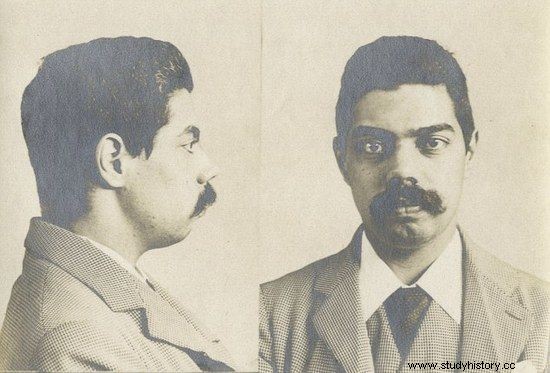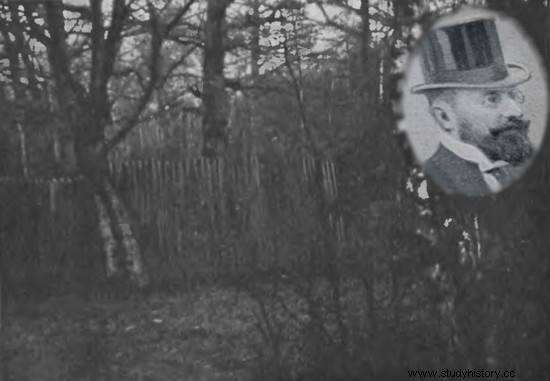The prince was found dead in the park. He was shot while he tried to flee. The first bullet hit the spine, another hit the ear. "The bullet of the second shot blew up the eye," said the doctor after the autopsy. Could it be that the prince was killed by his friend? Or maybe someone else, who even the creator of Sherlock Holmes, Arthur Conan Doyle, was afraid of?
A boa snake slips into the bedroom of a British officer serving in West Africa. Fortunately, the man wakes up at the last moment, sees a monstrous shape hanging from a fan and avoids certain death! Arthur Conan Doyle was so intrigued by this report, read in the press, that he wrote the short story "The Spotted Ribbon".
He had more similar inspirations - apparently he liked to draw examples from life. In fact, when "The Speckled Ribbon" and other stories about the superdetective Sherlock Holmes made the author famous, began to receive letters asking for help in solving real criminal riddles and scandals.

Arthur Conan Doyle. We owe him the figure of the most famous detective in history.
Madness, doomed to failure in advance? After all, a crime fiction writer is not the same as a detective! Yet the writer was doing surprisingly well. He explained, among others the case of George Edalji, a lawyer from an Indian immigrant family accused of mutilating farm animals in Staffordshire.
It turned out that the police believed the absurd rumors spread by the "benevolent" and ignored the facts. Arthur Conan Doyle was not afraid to point it out, he had Edalji released and restored his good name.
The creator of Holmes also stood up for a certain Oscar Slater, sentenced to life imprisonment for the murder of a wealthy old lady from Glasgow. He was sent to prison on the basis of circumstantial evidence, without clear evidence, as the writer stated in the brochure from 1912.

If it wasn't for Arthur Conan Doyle, George Edalji would probably have been behind bars for a long time.
Help! Warsaw is waiting
Given Arthur Conan Doyle's reputation, it is no wonder that he received a letter asking for help also from the then Polish - or rather its substitute, which was the Congress Poland trampled down by the tsarist authorities.
October 19, 1913, Warsaw
Sir,

You will learn even more about Polish traces in great history by reading Adam Węgłowski's book. "A very Polish history of everything" (Znak Horyzont 2015).
I have been one of your regular and grateful readers for many years, so I allow myself to write these words, even though I am a complete stranger to you and a foreigner. Well there will soon be a murder trial in Warsaw, which promises to be one of the most sensational in history.
The murdered prince of Lubeck and the alleged murderer - his friend Mr. de Bisping - are well known in the Warsaw society. Bisping assures him that he is innocent, and everyone who knows him finds it impossible for him to be capable of committing such a crime. However, to date, he is under a lot of circumstances and no other murderer or suspect has been found.
It is precisely for the solution of this mystery that I allow myself to write to you. Would you like to come to Warsaw and offer your valuable help and advice to Mr. de Bisping's lawyer? Perhaps I am wrong in thinking that you are undertaking such investigations. If, however, you were willing to help solve this mystery, for what fee, including travel and accommodation costs?
I haven't suggested any of your support to the Bisping family yet, but with your permission, I can write to them right away. Your name and works are so well known in Russia and Poland that I am sure that your help will be met with the greatest recognition. I'm sorry to let myself occupy your time, but I am one of your great devotees,
Felix de Halpert

Władysław, Fr. Drucki-Lubecki and the place where his body was found in the forest in Teresin near Warsaw.
We are talking about the murder of prince Władysław Drucki-Lubecki. It happened in a forest in Teresin near Warsaw on April 21, 1913. The murdered was the grandson of the former Minister of the Treasury of the Kingdom of Poland, a rich and influential man. He purchased the Teresian goods only four years before his tragic death.
Suspect Jan Bisping was his business partner, ordinate of Massalany, holding the honorary title of papal chamberlain, married to Maria née Zamoyska - widow of the Duke of Radziwille. It was about the people of the elite!
Mystery in Teresin
When the information about the crime reached Warsaw, it caused shock, disbelief and ... a hunger for information. Reporters followed the judicial authorities to the scene of the crime. The entire Congress Poland lived through the process before the outbreak of World War I.
Unfortunately, Arthur Conan Doyle did not want to listen to the request of the Bisping friend, de Halpert, and did not come to the Vistula. There, several hundred witnesses were questioned in the case (although none of them was a direct witness of the crime) and it was suggested that Drucki-Lubecki and Bisping had argued over money.
This article has more than one page. Please select another one below to continue reading.Attention! You are not on the first page of the article. If you want to read from the beginning click here.

Ordynat Jan Bisping in a drawing from Tygodnik Ilustrowany.
The autopsy report described the condition of the dead body in the following way:"First of all, a dozen bruised-cut wounds were found on the face and baldness, but so superficial that neither could have been the direct cause of death.
Further, there were two gunshot wounds inflicted with seemingly small-caliber firearms. Both shots were aimed at the rear and at close range, one at the right side of the spine and the other behind the ear. The bullet on the second shot blew up the eye.
The prince was of a weak complexion and did not have a more outstanding physical strength. Everything seems to prove that the attacked person suddenly tried to defend himself, and having assessed the danger (the prince had no weapon with him), he ran away. Then the murderer's shots were fired, both fatal. ”
The murder weapon was Bisping's, and his hair was on the deceased's glove. So the court had no doubts. Bisping was found guilty and sentenced to "elation murder". However, his appeal against the sentence and the subsequent 14 years of trials (before a Russian and then Polish court) led to his exoneration.

The court of first instance found Jan Bisping guilty and sentenced him to "murder in exultation". However, this was only the beginning of a 14-year judicial battle, as a result of which the ordinate was finally acquitted.
The evidence in the form of weapons and hair proved inconclusive. In addition, Bisping suffered from hand paresis. So how could he beat Drucki-Lubecki so that he started to run away from him? It didn't add up.
Did Ochrana scare the detective?
So if Bisping didn't kill then who? And does this have something to do with the reluctance of the creator of Sherlock Holmes to deal with the scandal?
In the book "Conan Doyle Detective" Peter Costello points out that the writer may have been afraid of possible political overtones of the case. Congresswoman, ruled firmly by the Russian authorities, was not the law-abiding Great Britain. And the tsarist police would not allow them to point out their mistakes. It would be a foreign, even hostile environment for Holmes' creator.
According to Michał Radziwiłł, Bisping's stepson, an open secret was participation in the murder of tsarist spies :"Lubecki was killed by Russian agents because, together with Baron de Bisping, he acquired properties around Fort Grodno, where large fortifications were planned, and they wanted to get rid of both partners, who had detailed knowledge of the works underway."
Was the writer-detective then frightened by Tsarist Ochrana? It is not comforting. We'd rather believe that nothing could stop him, and neither could his character.

Judges who adjudicated the case of Baron Jan Bisping. Was the tsarist Ochrana behind their decision?
Unless it was otherwise. Perhaps the author did not want to take up the case of a wealthy aristocrat who seemed to have all the resources to take care of his own affairs? Perhaps if Arthur Conan Doyle found out that there were machinations at stake on the part of the tsarist services, only then would he consider it a challenge worthy of Sherlock Holmes' father?
More unknown Polish tropes from world history can be found in Adam Węgłowski's book "A very Polish history of everything".
